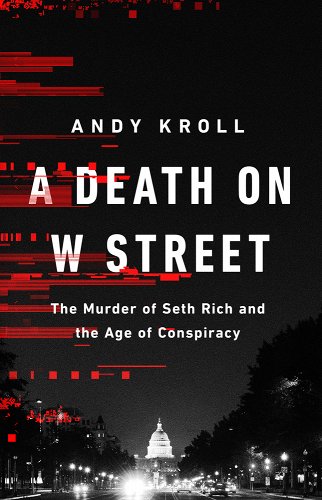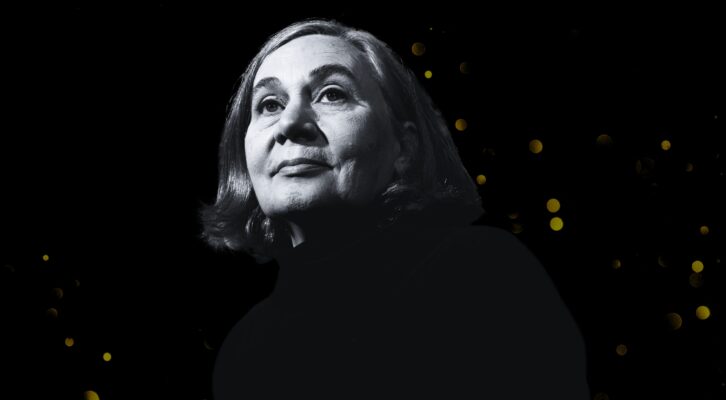Eelco Bosch van Rosenthal snuck a final look at his notes before the cameras rolled. Trim, early forties, with piercing blue eyes, van Rosenthal was an anchor for Nieuwsuur, a highly popular news show in the Netherlands. He had been a correspondent for the network and had reported from all over the world, including six years in Washington covering the Obama presidency. He spoke fluent English and had a reputation as a dogged interviewer, and he knew he would need to be on his game for the guest now dialing into the studio.
Van Rosenthal had dealt with Julian Assange before, once spending a maddening week in Iceland, where WikiLeaks had a temporary base of operations, trying to report on some of the leaked US diplomatic cables released in the Cablegate publication. He knew Assange to be a prickly character and a tough subject—evasive, combative, quick to reject the premise of a question or launch into a self-righteous lecture.
WikiLeaks had just published the “DNC Leaks,” an archive of nearly twenty thousand internal emails, strategy memos, and other documents from inside the Democratic National Committee. By Assange’s standards the emails were far less powerful than the Collateral Murder video or any one of the many revelations brought to light in Cablegate. But the DNC documents did offer a rare look at the inner workings of a major political party, a place where sharp elbows and testy arguments were the norm. They depicted a world more like the dark satire Veep than the feel-good drama The West Wing. The emails also revealed a level of antipathy voiced by some DNC employees toward Sanders and his campaign. In one email senior DNC employees suggested hurting Sanders’s candidacy by saying he was an atheist (he was Jewish). In another Chairwoman Debbie Wasserman Schultz called a top Sanders aide a “damn liar.” The leaked messages seemed to confirm some of what Sanders’s supporters had suspected all along—that the DNC, or elements of it, hated Sanders and wanted Clinton to win.
WikiLeaks timed its release of the emails for the eve of the Democratic National Convention, when the political press corps was primed to write about them. Until that moment the mainstream media had mostly ignored Sanders’s claims that the DNC had it out for him. But with the emails to prove it, news outlets couldn’t resist covering the story, plunging the party into chaos just before the convention. The outcry led to the resignations of Wasserman Schultz and Amy Dacey, the DNC’s chief executive. The convention was meant to be a chance to heal the rift between the pro-Sanders progressive left and the establishment camp that backed Clinton. Instead Sanders’s supporters staged a revolt on the convention floor in protest.
Assange was inundated with interview requests to discuss the DNC Leaks. He was asked often about the provenance of the emails. Wasn’t it true that Russian hackers had stolen the emails, as cybersecurity experts who reviewed the data from the DNC’s network concluded? Assange bristled at the suggestion that a hostile state actor had used WikiLeaks to launder the emails. WikiLeaks, Assange said, never confirmed or denied the identities of its sources. “We like to create maximum ambiguity as to who our sources are,” he said.
In the interviews, he dropped what appeared to be small clues—or were they feints?—about the provenance of the emails. “It’s, I think, interesting and acceptable to speculate who our sources are,” he said in one TV interview. “But if we’re talking about the DNC, there’s lots of consultants that have access, lots of programmers.” He claimed the DNC had been hacked dozens and dozens of times but gave no evidence to support this claim. He remarked that it was up to the sources themselves to reveal their identities and their role. “Perhaps one day the source or sources will step forward, and it might be an interesting moment,” he said. “Some people will have egg on their faces.”
Van Rosenthal, the Nieuwsuur anchor, had studied the recent interviews Assange had given and noted the irritation in Assange’s voice when asked about the Russian hacking allegations. When it was his turn to question Assange, he pressed the WikiLeaks founder on the Russian connection. How could a self-proclaimed believer in democracy and transparency accept stolen emails from Russia, a country where dissidents were imprisoned, defectors poisoned, and independent journalists murdered for reporting the truth about powerful elites?
“Well, that’s false,” Assange replied. The Russian hacking story was nonsense, he said, ginned up by the Clinton campaign “to try and distract from the revelations of rigging the nomination process.” By screaming “Russia, Russia, Russia” all the time, he added, WikiLeaks’ critics were engaging in a modern form of McCarthyism.
But if a foreign government were interfering in an American election, van Rosenthal asked, didn’t the public deserve to know? Couldn’t what WikiLeaks was doing be considered interfering with an election? The DNC Leaks had nothing to do with his distaste for Clinton or help from Russian hackers, Assange insisted. The principle behind every one of WikiLeaks’ publications was to expose how power truly worked, and now the organization had given American voters valuable information for when they cast their vote in November.
Van Rosenthal changed subjects. He mentioned Donald Trump’s sinking support in the polls. At that point, it seemed, only a so-called October surprise could save Trump’s campaign. Did WikiLeaks have any such bombshells in its possession?
“WikiLeaks never sits on material,” Assange said. Doing so would be a disservice to the sources who risked their jobs and sometimes their lives to get information to WikiLeaks. “There’s a twenty-seven-year-old works for the DNC,” Assange went on, “[who] was shot in the back, murdered just two weeks ago for unknown reasons as he was walking down the street in Washington.”
Van Rosenthal felt a prickle of recognition. When he lived in DC, he had read the Washington Post’s Metro section every day. He continued to read it after he had moved back to Amsterdam. He had followed the paper’s coverage of Seth Rich’s murder.
“That was just a robbery, I believe. Wasn’t it?” he interjected.
“No. There is no finding,” Assange replied.
“What are you suggesting?”
“I’m suggesting that our sources take risks, and they are—they become concerned to see things occurring like that.”
“Was he one of your sources, then?”
“We don’t comment on who our sources are.”
“Then why make the suggestion about a young guy being shot in the streets of Washington?”
Assange repeated what he’d already said—that it was concerning to WikiLeaks’ sources to know that a political aide had been gunned down in the middle of a contentious presidential campaign. The murder only underscored the “serious risks” those sources faced.
Van Rosenthal wasn’t buying it. “But it’s quite something to suggest a murder,” he said. “That’s basically what you’re doing.”
“Others have suggested that,” Assange said. “We are investigating to understand what happened in that situation with Seth Rich. I think it is a concerning situation. There’s not a conclusion yet. But we are concerned about it.”
When the interview was over, van Rosenthal spoke with his editor. They had a decision to make. Van Rosenthal was stunned that Assange had implicated Seth in the DNC leak without any evidence to back it up—at the very least, it was reckless, and possibly worse. Because the interview was conducted in English, it was taped an hour before Nieuwsuur went live in the Netherlands so it could be translated and captioned in Dutch. Should they edit out Assange’s comments about Rich? His editor argued that Assange had made real news, hinting at his possible source, and the clip would surely get a good deal of attention. They decided to keep Assange’s comments about Seth. “To be honest,” van Rosenthal would say years later, “I’m not completely sure that was the right decision.”
***
In the days after the murder, it had unnerved Aaron to watch his brother’s name and photo ricochet around the internet. Aaron treated the theories about Seth like a temporary annoyance. It was a presidential campaign year; people were riled up. With enough time this brief fit of madness would fade away. People would move on.
Just when it felt like the initial frenzy after Seth’s murder had subsided, Aaron noticed a surge in activity on the morning of August 9. It didn’t take much searching to find out why: WikiLeaks had announced on Twitter a $20,000 reward for information about Seth’s murder. But why? What did WikiLeaks want to do with Seth? Aaron eventually found his way to a short clip of Assange’s interview with a Dutch news anchor about the DNC leaks. “There’s a twenty-seven-year-old works for the DNC,” Aaron heard Assange say. “Our sources take risks.”
There were, by that point, several versions of the theories about Seth circulating on social media. The far-left Bernie fanatics claimed he’d been murdered for trying to expose corruption at the DNC, possibly at the behest of the Clinton family. A few fringe websites speculated that unknown hitmen had killed him for discovering the hack-and-leak operation as it was happening. But Assange’s comments ignited a new version of the theory, one that would take hold in far-right circles. The appeal of this story to Donald Trump’s supporters was obvious: if a disgruntled young Democrat had stolen the emails from his employer and provided them to WikiLeaks, then the culprit for that brazen cybercrime, a Watergate for the digital age, was not Russia. The allegation that Russia had interfered in the election to help Trump and damage Clinton, or that Trump’s campaign had somehow conspired with Russians—all of it was bunk. Trump had been right the whole time when he called the Russian interference story “fake news.”
On social media Trump’s followers mobilized around this theory. More than eighty thousand tweets with the hashtag #SethRich appeared on Twitter within hours of the Nieuwsuur interview appearing online. You could trace the start of that viral surge to anonymous pro-Trump accounts that urged coordination. Take the Twitter account @NimbleNavgater. Soon after Assange’s interview went live, the account issued a rallying cry to its followers:
TWEET USING HASHTAGS #SethRich and #HisNameWasSethRich !!!
On the surface, @NimbleNavgater had all the hallmarks of a diehard Trump supporter. The account’s bio said she was “DANI THE DEM DESTROYER” who lived in Boston, Massachusetts. She joined Twitter in March 2016 and spent nearly all of her time on the platform pushing pro-Trump messages and memes while attacking anyone who said a mean word about him—Barack Obama, Hillary Clinton, Ted Cruz, feminists, Cher. She reveled in any setback for Clinton’s campaign (“FBI recovers 30 new Clinton emails dealing with Benghazi!”) and ran interference with every new Trump-related scandal. What you couldn’t find in @NimbleNavgater’s tweets was any confirmation that she was who she said she was, or that she was a real person at all. @NimbleNavgater could have been a working mom in Boston, a fifty-year-old lawyer in Fresno, a bratty teenager in Brazil, or a bot—and there was no way to know in the moment. At any one time, thousands of fake accounts mixed in with real ones promoted certain hashtags, gaming the algorithm to make a topic go viral, creating buzz and critical mass.
Seth Rich is one of SEVEN Clinton affiliates murdered this month. This is no coincidence people. #HisNameWasSethRich
Julian Assange Suggests That DNC Staffer Shot To Death Was A WikiLeaks Source #SethRich #HisNameWasSethRich
An American patriot saw corruption in his own party and decided he wouldn’t help hide it. #HisNameWasSethRich
The hashtags #SethRich and #HisNameWasSethRich trended for several hours, which caused conservative influencers with much larger followings to take notice. Curt Schilling, the former Boston Red Sox pitcher turned belligerent right-wing podcaster, shared one of @NimbleNavgater’s Seth Rich tweets to his 160,000 Twitter followers. Mike Cernovich, a leading voice in the misogynist alt-right, sent this tweet to his eighty thousand followers: “Was Seth Rich, the source of #DNCleaks, murdered?” The Gateway Pundit, a fringe blog, included these tweets and Assange’s Nieuwsuur interview in a story titled “WOW! BREAKING=> Julian Assange Suggests Seth Rich – Who Was MURDERED in DC – Was Wikileaks DNC Source!”
From there the Assange-fueled conspiracy theory landed on the front page of The Drudge Report, one of the most visited websites on the English-language internet. Drudge’s title read, “It Wasn’t the Russians . . . Julian Assange Fingers Murdered DNC Staffer.” The Daily Mail covered Assange’s comments, as did Sputnik News, the English-language propaganda site funded by the Russian government; the Ghana News Agency; Iran’s Fars government news service; and newspapers from France to New Zealand. The Twitter account for the Chinese Communist Party’s youth wing told its four million members, “The sources of the Hillary leaked emails were murdered, one after another? This is the truth of Western democracy!”
This was how a conspiracy theory went viral: a vaguely worded insinuation by a well-known figure found an eager audience on social media; fringe blogs and websites grabbed a few of those posts and compiled them into a story; aggregator sites shared the stories to millions; and mainstream outlets saw the aggregation and treated it like national news. The surest sign that the theories about Seth had reached a critical mass was when Fox News picked them up. For an entire day, from Fox & Friends in the morning to Megyn Kelly and Lou Dobbs at night, Fox aired wall-to-wall coverage of Assange’s interview and the WikiLeaks reward. Eric Bolling, who was filling in for primetime host Bill O’Reilly, didn’t hold back. “There wasn’t a robbery,” Bolling said. “They weren’t even trying to get his information. This was a hit.”
Assange’s Nieuwsuur interview drove so much activity online that the FBI took notice and discussed how it should respond to possible inquiries. A public-affairs employee in the bureau’s Washington Field Office mentioned the widespread coverage of Assange’s comments and asked if the agency had any involvement in the Rich homicide investigation. “I’m aware of this reporting from earlier this week,” a colleague replied, “but not any specific involvement in any related case.”
It was one thing for the claims about Seth to be a meme or a rumor. It was quite another for a national news network—at least in the minds of its viewers—to suggest that he had been murdered because he was Assange’s source. Whether they were true or not, whatever dark and disturbing corner of the internet they had crawled out of, the claims had for the first time gone mainstream. And to a powerful class of political professionals, the conspiracy theories about Seth had suddenly become useful. Just as the deaths of people like Vince Foster and Caity Mahoney had been turned into conspiracy theories to be used against Bill Clinton, the baseless claim that a dead DNC staffer was in fact a disillusioned insider who gave stolen emails to WikiLeaks could now be used against Hillary Clinton. Roger Stone—the dapper-dressing, dirty-trick-loving Republican operative who had advised Donald Trump for years—tweeted that Assange’s remarks confirmed Seth had a role in the “DNC heist.” In another tweet, he included a photo of Seth alongside three other supposed Clinton victims:
Four more dead bodies in the Clinton’s wake. Coincidence? I think not.
***
To anyone who knew Seth well or worked closely with him, the idea that he was a criminal mastermind who had hacked the DNC from the inside was laughable. He sometimes locked himself out of his own email account. A friend had to teach him how to use Twitter. Andrew Therriault had given Seth a book on how to learn a coding language known as Python, but it looked like Seth never opened the book. “He wasn’t good enough to grab the data that they think he grabbed to uncover a conspiracy that could not have existed without me knowing about it,” Pratt Wiley, his old boss, would later say. “I’m glad people are projecting his skills as superhuman, but that’s not the Seth that I paid every week.”
The supposed motive for this theoretical crime—that Seth was a Sanders supporter who wanted to expose Clinton’s corruption—didn’t make sense either. Seth took the DNC’s neutrality so seriously he refused to tell his friends or family members which candidate he preferred. (He did make his feelings known about Trump, whom he called a “giant orange baby,” according to a friend from high school.) He liked some of the policies Sanders had proposed, he told Mary, but he knew there was no realistic way to pay for all of it. Plus, if he were such a Sanders diehard, why would he have wanted a job on the Clinton campaign? In the event he did have a grievance with the DNC or the Clintons, his parents believed that Seth’s patriotism—his love of country and democracy—meant he would have shared those concerns through the appropriate channels, not by committing a massive crime against his own employer.
Aaron watched the Assange clip over and over, first in disbelief, then in anger. He worked for a defense contractor, a job that required him to hold a clearance. Now, for the first time, he felt like he needed to inform his security officer about what was happening online. He feared that if he didn’t, it could endanger his clearance.
Reporters from across the country and around the world wanted a reaction to Assange’s remarks and the WikiLeaks reward offer. Aaron called Seth’s former colleague and mentor Andrew Therriault. “This is getting to be more than we can handle,” he said. “We need help.” Through some of Seth’s former colleagues, the Riches got in touch with a man named Brad Bauman, a PR consultant who had kicked around Democratic politics for years. Bauman had read about Seth’s murder but hadn’t followed the aftermath. After talking to Joel and Mary on the phone, he couldn’t say no to them given what they’d gone through. Figuring he was signing up for a few weeks of pro bono work, he agreed to act as the family’s spokesman, and he helped them put out a statement that responded to Assange and asked the public to “refrain from pushing unproven and harmful theories about Seth’s murder.”
WikiLeaks, for its part, issued its own statement in response to the outcry. “We treat threats towards any suspected WikiLeaks sources with extreme gravity,” it said. “This should not be taken to imply that Seth Rich was a source to WikiLeaks or that his murder is connected to our publications.” Assange himself continued to stoke the theories. “We don’t disclose sources,” he said in a different interview, “even dead sources.”
___________________________________
Excerpted from A Death on W Street: The Murder of Seth Rich and the Age of Conspiracy by Andy Kroll . Copyright 2022. Available from PublicAffairs, an imprint of Hachette Book Group, Inc.
















